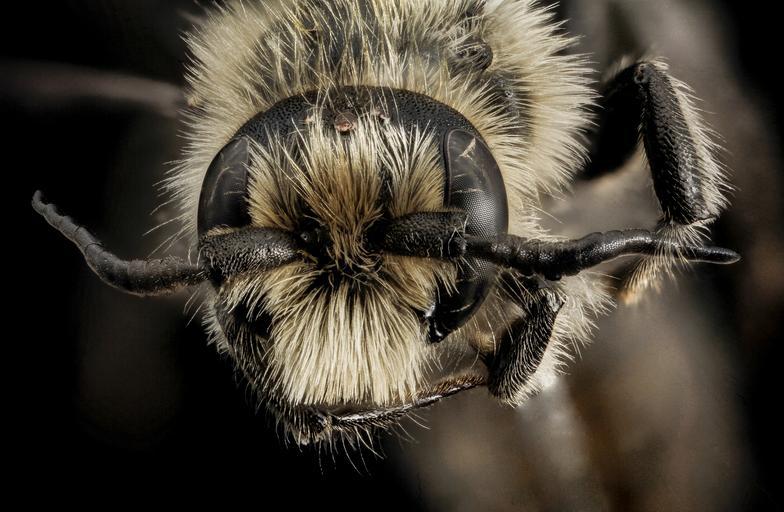MAKE A MEME
View Large Image

| View Original: | Hoplitis_spoliata,_male,_face,_NY,_Franklin_Co_2014-07-01-12.32.21_ZS_PMax.jpg (5354x3495) | |||
| Download: | Original | Medium | Small | Thumb |
| Courtesy of: | www.flickr.com | More Like This | ||
| Keywords: hoplitis megachilidae hoplitis spoliata hoplitisspoliata taxonomy:binomial=hoplitis spoliata taxonomy:binomial=hoplitisspoliata male antennae adirondacks new york newyork mountains adirondack mountains adirondackmountains bee bees biml usgs droege sam droege samdroege bioblitz northern stackshot zerene stacker zerenestacker close up macro macro photography macrophotography close up closeup animal texture photo border black background serene outdoor depth of field Sometimes male bees depart from the standard antennae shapes for some sort of new performance specs. No body seems to be studying why this might be, but there is substantive research on how incredible antennae can be at detecting just a few molecules. In this species (Hoplitis spoliata) you can see that the antennal segments widen out towards the center of the antennae and then narrow again. Why? Pictures taken at the Adirondack BioBlitz by Dejen Mengis. ~~~~~~~~~~{{{{{{0}}}}}}~~~~~~~~~~ All photographs are public domain, feel free to download and use as you wish. Photography Information: Canon Mark II 5D, Zerene Stacker, Stackshot Sled, 65mm Canon MP-E 1-5X macro lens, Twin Macro Flash in Styrofoam Cooler, F5.0, ISO 100, Shutter Speed 200 The grass so little has to do, A sphere of simple green, With only butterflies to brood, And bees to entertain, - Emily Dickinson Want some Useful Links to the Techniques We Use? Well now here you go Citizen: Basic USGSBIML set up: www.youtube.com/watch?v=S-_yvIsucOY USGSBIML Photoshopping Technique: Note that we now have added using the burn tool at 50% opacity set to shadows to clean up the halos that bleed into the black background from "hot" color sections of the picture. www.youtube.com/watch?v=Bdmx_8zqvN4 PDF of Basic USGSBIML Photography Set Up: ftp://ftpext.usgs.gov/pub/er/md/laurel/Droege/How%20to%20Take%20MacroPhotographs%20of%20Insects%20BIML%20Lab2.pdf Google Hangout Demonstration of Techniques: plus.google.com/events/c5569losvskrv2nu606ltof8odo or www.youtube.com/watch?v=4c15neFttoU Excellent Technical Form on Stacking: www.photomacrography.net/ Contact information: Sam Droege sdroege@usgs.gov 301 497 5840 Sometimes male bees depart from the standard antennae shapes for some sort of new performance specs. No body seems to be studying why this might be, but there is substantive research on how incredible antennae can be at detecting just a few molecules. In this species (Hoplitis spoliata) you can see that the antennal segments widen out towards the center of the antennae and then narrow again. Why? Pictures taken at the Adirondack BioBlitz by Dejen Mengis. ~~~~~~~~~~{{{{{{0}}}}}}~~~~~~~~~~ All photographs are public domain, feel free to download and use as you wish. Photography Information: Canon Mark II 5D, Zerene Stacker, Stackshot Sled, 65mm Canon MP-E 1-5X macro lens, Twin Macro Flash in Styrofoam Cooler, F5.0, ISO 100, Shutter Speed 200 The grass so little has to do, A sphere of simple green, With only butterflies to brood, And bees to entertain, - Emily Dickinson Want some Useful Links to the Techniques We Use? Well now here you go Citizen: Basic USGSBIML set up: www.youtube.com/watch?v=S-_yvIsucOY USGSBIML Photoshopping Technique: Note that we now have added using the burn tool at 50% opacity set to shadows to clean up the halos that bleed into the black background from "hot" color sections of the picture. www.youtube.com/watch?v=Bdmx_8zqvN4 PDF of Basic USGSBIML Photography Set Up: ftp://ftpext.usgs.gov/pub/er/md/laurel/Droege/How%20to%20Take%20MacroPhotographs%20of%20Insects%20BIML%20Lab2.pdf Google Hangout Demonstration of Techniques: plus.google.com/events/c5569losvskrv2nu606ltof8odo or www.youtube.com/watch?v=4c15neFttoU Excellent Technical Form on Stacking: www.photomacrography.net/ Contact information: Sam Droege sdroege@usgs.gov 301 497 5840 | ||||